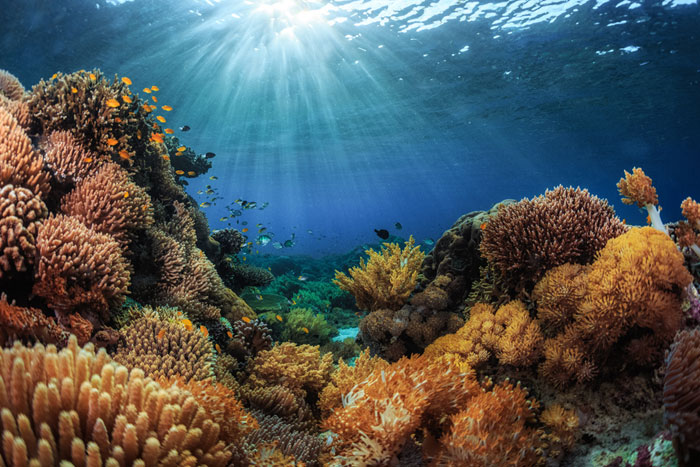- PRODUCTS
- MODEL LIST
- APPLICATIONS
- SUPPORT
- SALES/SERVICE
- BLOG
- ABOUT
Coral Reef Monitoring

Coral reefs host a vast array of biodiversity and support a vibrant fisheries industry. Yet, despite their environmental and economic value, many of these reefs are listed as high risk for destruction from human impacts, and are particularly sensitive to environmental impacts. Growing populations in coastal regions are imposing increased pressure on coral reefs from human impacts such as habitat destruction and harmful algal blooms, while global issues like climate change and ocean acidification threaten reefs around the world. To protect these reefs, proper management is key. This requires the right tools.
What Causes Coral Reef Degradation?
Environmental stressors of all kinds have impacts on coral reefs and the species that inhabit them. Many of these are the result of human impacts, ranging from local issues like eutrophication and pollution to global issues like ocean acidification.
- Water temperature – All species thrive in a specific temperature range. Coral species are particularly vultnerable to changing temperatures. Warming water can cause coral bleaching, where the coral expel symbiotic zooxanthellae and take on a white appearance.
- Dissolved Oxygen must be within a range that supports sea life. Low or anoxic conditions resulting from upwelling, pollution, or eutrophication can create large “dead zones” that cause widespread mortality within the reef. Tracking long-term water quality within a reef can help predict these events.
- Ocean acidification is of particular concern. As the pH of water becomes more acidic, the calcium carbonate used by organisms to build shells and corals begins to dissolve. Slow growing coral species may degrade faster than they can grow. Monitoring long-term trends of pH as well as discrete events is crucial for determining environmental health.
- Sedimentation and pollution can smother and choke corals and interfere with their growth. Suspended sediments also block the necessary light used for photosynthesis.
- Loading of nutrients such as Nitrate and Phosphate has been known to cause eutrophication, or rapid algal growth that leads to low oxygen. At a minimum, measuring nutrient concentrations is crucial for establishing a baseline. Understanding potential sources of nutrients from artificial sources can reduce the possibility of causing an algal bloom.
What Tools can Help with Coral Reef Monitoring?
- HydroCAT-EP V2 Multiparameter Probe – measures temperature, conductivity, pressure, dissolved oxygen, pH, chlorophyll, and turbidity in a single package. Designed for long-term deployments in biologically active areas..
- SeapHOx V2 ISFET pH and CTD + Dissolved Oxygen Sensor – the world’s best tool for tracking ocean acidification. This uses next-generation ISFET technology designed to withstand harsh conditions and provide highly accurate, precise, and stable pH for several months without recalibration.
- 37-SMP-ODO CTD and Dissolved Oxygen sensor – an oceanographic staple, measures temperature, conductivity, pressure, and dissolved oxygen in a robust package with internal memory and real-time output. Trusted around the world for high end oceanographic research.
- ECO Combination Optical Sensors measure fluorescence, turbidity, and backscattering for anything from measuring photosynthetic biomass within algal blooms to tracking rates of sedimentation.
- 39plus Temperature and Pressure Logger – robust and reliable temperature and optional pressure sensor with internal logging and real-time output.
- SBE 56 Miniature Temperature Logger - compact and reliable temperature sensor with internal logging
- SUNA V2 Nitrate Sensor – utilized optical UV technology for long-term high-resolution nitrate measurements without a chemistry lab.
- PAR Sensors measure photosynthetically active radiation added to the environment used by primary producers.
Case Studies
- Case Study - Paul Allen Foundation pH Sensors, Greg Ikeda, December 2018
- Case Study: Autonomous Systems Help To Understand Nutrient Sources Within The St. Lucie Estuary, Ian Walsh, December 2017
- Case Study: Measuring Nitrate in Puget Sound Using Optical Sensors, Sea-Bird Scientific, November 2017
- Case Study: Identifying Oil In Water With The Seaowl UV-A™ Fluorescence and Backscattering Instrument, Ian Walsh, March 2018
- Case Study: Long-Term Water Quality Monitoring Deployments with the Sea-Bird Scientific HydroCAT-EP, Doug Wilson et al. May 2017

